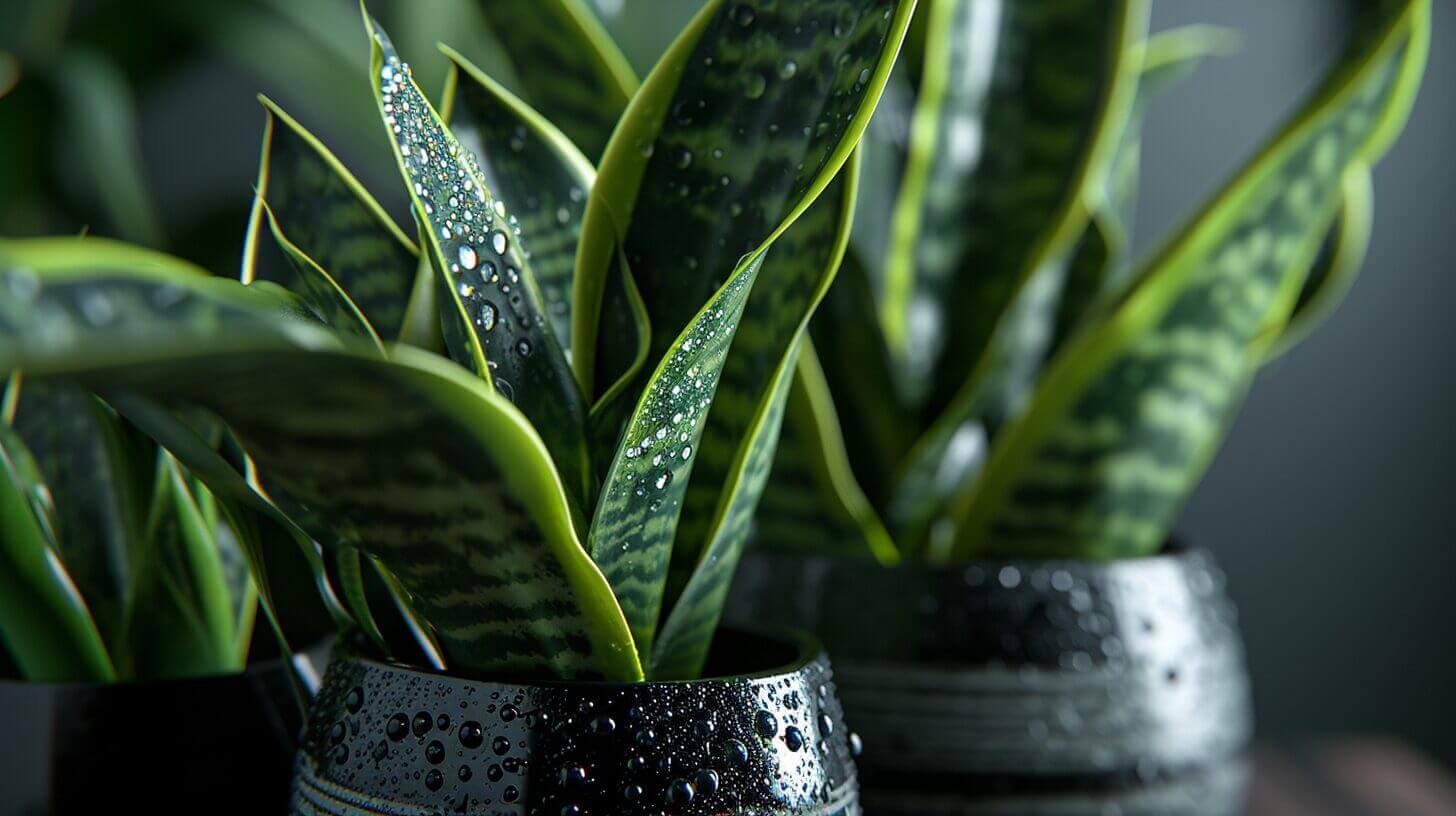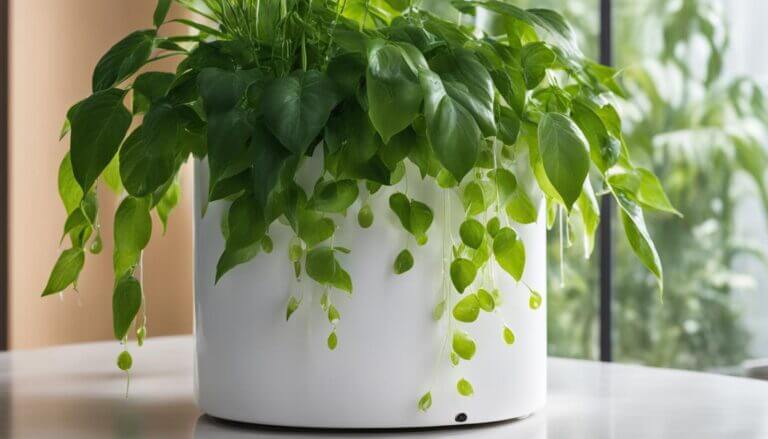How Often to Water a Snake Plant for Optimal Hydration: An Easy Care Guide
Want your snake plant to thrive? Understanding how often to water it is key. With thick leaves that store water, snake plants are practically designed for beginner gardeners. This hardy and low-maintenance tropical plant can easily be underwatered or overwatered. Water too little and its leaves may wrinkle; too much will lead to root rot.
The ideal care plan is to water a snake plant only when its soil is completely dry. The perfect soil mix, drainage, sunlight, and humidity will affect watering frequency. For most indoor snake plants, water every 2-3 weeks. Let the water drain fully to prevent disease. With these pro tips, your snake plant will flourish with strong, upright leaves. Caring for these architectural plants is easy with this complete guide to watering your sansevieria.
Key Takeaways
- The size of the snake plant affects watering needs
- Better to underwater than to overwater
- Maintaining optimal soil moisture is crucial for growth and vitality
- Wilting and drooping leaves indicate dehydration
Factors to Consider for Watering Snake Plant
When determining the watering schedule for a snake plant, it is crucial to consider factors such as the plant’s size, environment, and potting medium. These factors significantly determine the optimal moisture levels and watering frequency for your snake plant.
The size of the snake plant is a crucial factor to consider when determining its watering needs. Smaller plants generally require less water compared to larger ones. It is important to remember that snake plants are succulents and store water in their leaves. Hence, they are more tolerant of underwatering than overwatering. Overwatering can lead to root rot and other issues, so striking a balance is important.
The environment in which the snake plant is placed also affects its watering needs. The plant may require less frequent watering if it is in a warm, humid environment. On the other hand, if the plant is in a dry or drafty area, it may need more frequent watering to prevent dehydration.
The potting medium used for the snake plant also plays a role in its watering requirements. Well-draining soil is essential for snake plants as it helps prevent waterlogged roots. A mix of potting soil and perlite or sand can create the ideal medium for proper drainage.
Understanding the Watering Needs of Sansevieria
To accurately meet the watering needs of Sansevieria, it is essential to consider factors such as the plant’s size, environment, and potting medium. Sansevieria, commonly known as Snake Plant or Mother-in-Law’s Tongue, is a popular indoor plant known for its hardy nature and low maintenance requirements. However, understanding how often to water this plant is crucial for its overall health and well-being.
When it comes to watering frequency, it is important to strike a balance between providing enough moisture and avoiding overwatering. Sansevieria is a succulent plant that stores water in its leaves, making it more tolerant of drought conditions. Therefore, it is better to underwater than to overwater this plant. A general rule of thumb is to allow the top inch of the soil to dry out before watering again.
Watering Frequency for Sansevieria
| Plant Size | Environment | Potting Medium | Watering Frequency |
|---|---|---|---|
| Small | Dry | Well-draining | Once every 2 weeks |
| Medium | Humid | Loamy | Once a month |
| Large | Average | Sandy | Once every 6 weeks |
It is best to use the soak and dry method when it comes to watering methods. This involves thoroughly watering the plant until water drains out of the bottom of the pot and then allowing the soil to dry out completely before watering again. This method ensures that the roots receive adequate moisture without sitting in water for extended periods, preventing root rot.
The Importance of Soil Moisture for Snake Plant Watering
Maintaining the optimal soil moisture level is crucial for the health and well-being of snake plants, as it directly affects their growth and overall vitality. Snake plants, also known as Sansevieria, are hardy houseplants that are known for their ability to survive in low light conditions and dry environments. However, this doesn’t mean that they can thrive without any water at all. Proper plant hydration is essential for the snake plant’s overall health.
Snake plants prefer to be slightly under-watered rather than over-watered. Overwatering can lead to root rot and other fungal diseases, which can ultimately kill the plant. On the other hand, if the soil moisture level is too low, the snake plant may become dehydrated, and its leaves may start to droop or turn yellow.
To maintain the optimal soil moisture level for snake plants, it is important to water them thoroughly but infrequently. Allow the soil to dry out completely between waterings. This will prevent overwatering and promote healthy root growth. It is also important to use well-draining soil to avoid waterlogging.
In addition to proper watering, it is important to provide adequate humidity for snake plants. They thrive in environments with moderate humidity, so it may be helpful to mist the leaves occasionally or place a tray of water near the plant to increase humidity levels.
How to Tell When Your Snake Plant Needs Water
A wilting snake plant is a clear indicator that it is in need of water. However, it’s important to understand the signs of dehydration in order to prevent overwatering. Here are some key things to look out for:
- Drooping leaves: When a snake plant lacks water, it will start drooping and losing rigidity. This is a sign that the plant is dehydrated and needs to be watered.
- Dry soil: Another indication of dehydration is dry soil. If you notice that the soil is completely dry to the touch, it’s a sign that the snake plant is in need of water.
- Yellowing leaves: Overwatering can also be a problem for snake plants. If you see yellowing leaves or a mushy texture, it’s a sign that the plant is suffering from too much water.
To prevent overwatering, it’s important to water your snake plant sparingly. Allow the soil to dry out between waterings, and make sure that the pot has proper drainage to avoid waterlogging.
Pro Tips for Establishing a Watering Schedule for Sansevieria
One important tip for establishing a watering schedule for Sansevieria is observing the plant’s growth patterns and adjusting the watering frequency accordingly. Sansevieria, also known as Snake Plant or Mother-in-law’s Tongue, is a popular houseplant known for thriving in low-light conditions and tolerating neglect. However, it is still important to provide it with proper care, including a consistent watering routine.
To establish a watering routine for Sansevieria, it is essential to understand its water requirements. These plants are native to arid regions of West Africa, so they are adapted to survive in dry conditions. Overwatering can lead to root rot and other issues, so it is crucial to avoid excessive watering.
A general rule of thumb is to water your Sansevieria when the top inch of the soil feels dry to the touch. This can vary depending on factors such as the size of the pot, the temperature, and the humidity levels in your home. In general, Sansevieria plants prefer to be slightly underwatered rather than overwatered.
Another useful tip is to use well-draining soil to prevent water from sitting in the pot and causing root rot. When watering, make sure to thoroughly saturate the soil, allowing water to flow out of the drainage holes at the bottom of the pot. After watering, allow the soil to dry out completely before watering again.
Frequently Asked Questions(FAQ) Snake Plant Care Guide
Should I Repot My Snake Plant Before or After Watering It?
When considering transplanting sansevieria step by step, it’s best to do it before watering your snake plant. This way, the soil is dry, making it easier to carefully remove the plant from its current pot. Once you’ve completed the transplant, water it thoroughly and allow the soil to drain before placing it in a new location.
What is the Proper Watering Schedule for Snake Plants to Ensure Healthy Growth?
A proper watering schedule is crucial for the healthy growth of snake plants. To ensure their well-being, it is important to learn how to care for sansevieria. The recommended approach is to water them once every 2-3 weeks, allowing the soil to dry out completely between waterings. Overwatering can lead to root rot, so make sure the pot has adequate drainage. Remember, following a consistent watering routine is key to keeping your snake plants thriving.
Can I Use Tap Water to Water My Snake Plant?
Tap water can be used to water snake plants, but it is important to consider the quality of the water. Tap water may contain minerals or chemicals that can potentially harm the plant. Distilled water is a safer option to ensure optimal plant health.
Can I Use a Self-Watering Pot for My Snake Plant?
Self-watering pots can be a convenient option for snake plants. They provide a consistent moisture level, ensuring the plant’s needs are met. However, alternative watering methods, such as regular watering with proper drainage, can also be effective.
How often should I water my snake plant?
Snake plants require very little water and can actually be overwatered easily. It is recommended to water your snake plant every 2-4 weeks.
How much light does a snake plant need?
Snake plants prefer bright, indirect light but can also tolerate low light conditions. They can even survive in rooms with no natural light.
How do I know if my snake plant is overwatered?
Overwatering can cause the roots of the snake plant to rot. Signs of overwatering include yellowing leaves, soft and mushy leaves, or a foul smell coming from the soil.
What are some care tips for snake plants?
Snake plants are known for their easy care. Here are some tips: – Use well-draining soil mix. – Allow the soil to dry out between waterings. – Avoid placing it in direct sunlight. – Keep the plant away from cold drafts. – Clean the leaves with a damp cloth to remove dust.
How often should I repot snake plants?
Snake plants don’t require frequent repotting. It is recommended to repot them every 2-3 years or when the roots start to outgrow the pot.
Where is the best place to put my snake plant?
Snake plants can thrive in various light conditions and can grow in both bright and low light spots. However, placing your snake plant in a spot with bright, indirect light for optimal growth is best.
Do snake plants flower?
Yes, snake plants occasionally bloom, but it is rare for them to flower indoors.
How long can snake plants go without water?
Snake plants are very resilient and can go without water for several weeks. Their leaves store water, allowing them to survive in drought-like conditions.
How do I water a snake plant?
The best way to water a snake plant is to thoroughly soak the soil and allow it to dry out completely before watering again. Avoid overwatering as it can lead to root rot.
How often should I water snake plants outdoors?
When grown outdoors, snake plants should be watered more frequently, especially during hot and dry weather. Watering them every 7-10 days is recommended, depending on the weather conditions.
How do I know when to water my snake plant?
You can check if your snake plant needs water by sticking your finger about an inch into the soil. If it feels dry, it’s time to water. If the soil is still moist, you should wait a bit longer.
How Does the Amount of Light Affect the Watering Schedule for Snake Plants?
Optimize Your Snake Plant’s Light to determine the best watering schedule. Snake plants require bright but indirect light, as direct sunlight can cause damage. Adjust the watering frequency based on the amount of light your plant receives. Less light means slower growth and less water absorption, so water sparingly. More light triggers faster growth and increased water requirements, so water more frequently. Find the right balance to ensure your snake plant thrives.
How much water should I give my snake plant?
Snake plants are adapted to survive in dry conditions, so they don’t need a lot of water. When you do water, make sure to give it a good soak, allowing the water to drain out of the pot completely.
Can snake plants hold water in their leaves?
Snake plants have thick, succulent leaves that can store water, so they don’t rely on frequent watering. This makes them the perfect plant for people who tend to forget to water their plants!
Can snake plants grow well outdoors?
Snake plants can grow outdoors in warm climates, but they are also perfectly suited to indoor environments. They are easy to care for and can thrive with minimal sunlight and waterA proper watering schedule is crucial for theake Plant for Optimal Hydration: An Easy Care Guide
Want your snake plant to thrive? Understanding how often to water it is key. With thick leaves that store water, snake plants are practically designed for beginner gardeners. This hardy and low-maintenance tropical plant can easily be underwatered or overwatered. Water too little and its leaves may wrinkle; too much will lead to root rot.
The ideal care plan is to water a snake plant only when its soil is completely dry. The perfect soil mix, drainage, sunlight, and humidity will affect watering frequency. For most indoor snake plants, water every 2-3 weeks. Let the water drain fully to prevent disease. With these pro tips, your snake plant will flourish with strong, upright leaves. Caring for these architectural plants is easy with this complete guide to watering your sansevieria.
Key Takeaways
- The size of the snake plant affects watering needs
- Better to underwater than to overwater
- Maintaining optimal soil moisture is crucial for growth and vitality
- Wilting and drooping leaves indicate dehydration
Factors to Consider for Watering Snake Plant
When determining the watering schedule for a snake plant, it is crucial to consider factors such as the plant’s size, environment, and potting medium. These factors significantly determine the optimal moisture levels and watering frequency for your snake plant.
The size of the snake plant is a crucial factor to consider when determining its watering needs. Smaller plants generally require less water compared to larger ones. It is important to remember that snake plants are succulents and store water in their leaves. Hence, they are more tolerant of underwatering than overwatering. Overwatering can lead to root rot and other issues, so striking a balance is important.
The environment in which the snake plant is placed also affects its watering needs. The plant may require less frequent watering if it is in a warm, humid environment. On the other hand, if the plant is in a dry or drafty area, it may need more frequent watering to prevent dehydration.
The potting medium used for the snake plant also plays a role in its watering requirements. Well-draining soil is essential for snake plants as it helps prevent waterlogged roots. A mix of potting soil and perlite or sand can create the ideal medium for proper drainage.
Understanding the Watering Needs of Sansevieria
To accurately meet the watering needs of Sansevieria, it is essential to consider factors such as the plant’s size, environment, and potting medium. Sansevieria, commonly known as Snake Plant or Mother-in-Law’s Tongue, is a popular indoor plant known for its hardy nature and low maintenance requirements. However, understanding how often to water this plant is crucial for its overall health and well-being.
When it comes to watering frequency, it is important to strike a balance between providing enough moisture and avoiding overwatering. Sansevieria is a succulent plant that stores water in its leaves, making it more tolerant of drought conditions. Therefore, it is better to underwater than to overwater this plant. A general rule of thumb is to allow the top inch of the soil to dry out before watering again.
Watering Frequency for Sansevieria
| Plant Size | Environment | Potting Medium | Watering Frequency |
|---|---|---|---|
| Small | Dry | Well-draining | Once every 2 weeks |
| Medium | Humid | Loamy | Once a month |
| Large | Average | Sandy | Once every 6 weeks |
It is best to use the soak and dry method when it comes to watering methods. This involves thoroughly watering the plant until water drains out of the bottom of the pot and then allowing the soil to dry out completely before watering again. This method ensures that the roots receive adequate moisture without sitting in water for extended periods, preventing root rot.
The Importance of Soil Moisture for Snake Plant Watering
Maintaining the optimal soil moisture level is crucial for the health and well-being of snake plants, as it directly affects their growth and overall vitality. Snake plants, also known as Sansevieria, are hardy houseplants that are known for their ability to survive in low light conditions and dry environments. However, this doesn’t mean that they can thrive without any water at all. Proper plant hydration is essential for the snake plant’s overall health.
Snake plants prefer to be slightly under-watered rather than over-watered. Overwatering can lead to root rot and other fungal diseases, which can ultimately kill the plant. On the other hand, if the soil moisture level is too low, the snake plant may become dehydrated, and its leaves may start to droop or turn yellow.
To maintain the optimal soil moisture level for snake plants, it is important to water them thoroughly but infrequently. Allow the soil to dry out completely between waterings. This will prevent overwatering and promote healthy root growth. It is also important to use well-draining soil to avoid waterlogging.
In addition to proper watering, it is important to provide adequate humidity for snake plants. They thrive in environments with moderate humidity, so it may be helpful to mist the leaves occasionally or place a tray of water near the plant to increase humidity levels.
How to Tell When Your Snake Plant Needs Water
A wilting snake plant is a clear indicator that it is in need of water. However, it’s important to understand the signs of dehydration in order to prevent overwatering. Here are some key things to look out for:
- Drooping leaves: When a snake plant lacks water, it will start drooping and losing rigidity. This is a sign that the plant is dehydrated and needs to be watered.
- Dry soil: Another indication of dehydration is dry soil. If you notice that the soil is completely dry to the touch, it’s a sign that the snake plant is in need of water.
- Yellowing leaves: Overwatering can also be a problem for snake plants. If you see yellowing leaves or a mushy texture, it’s a sign that the plant is suffering from too much water.
To prevent overwatering, it’s important to water your snake plant sparingly. Allow the soil to dry out between waterings, and make sure that the pot has proper drainage to avoid waterlogging.
Pro Tips for Establishing a Watering Schedule for Sansevieria
One important tip for establishing a watering schedule for Sansevieria is observing the plant’s growth patterns and adjusting the watering frequency accordingly. Sansevieria, also known as Snake Plant or Mother-in-law’s Tongue, is a popular houseplant known for thriving in low-light conditions and tolerating neglect. However, it is still important to provide it with proper care, including a consistent watering routine.
To establish a watering routine for Sansevieria, it is essential to understand its water requirements. These plants are native to arid regions of West Africa, so they are adapted to survive in dry conditions. Overwatering can lead to root rot and other issues, so it is crucial to avoid excessive watering.
A general rule of thumb is to water your Sansevieria when the top inch of the soil feels dry to the touch. This can vary depending on factors such as the size of the pot, the temperature, and the humidity levels in your home. In general, Sansevieria plants prefer to be slightly underwatered rather than overwatered.
Another useful tip is to use well-draining soil to prevent water from sitting in the pot and causing root rot. When watering, make sure to thoroughly saturate the soil, allowing water to flow out of the drainage holes at the bottom of the pot. After watering, allow the soil to dry out completely before watering again.
Frequently Asked Questions(FAQ) Snake Plant Care Guide
Should I Repot My Snake Plant Before or After Watering It?
When considering transplanting sansevieria step by step, it’s best to do it before watering your snake plant. This way, the soil is dry, making it easier to carefully remove the plant from its current pot. Once you’ve completed the transplant, water it thoroughly and allow the soil to drain before placing it in a new location.
What is the Proper Watering Schedule for Snake Plants to Ensure Healthy Growth?
A proper watering schedule is crucial for the healthy growth of snake plants. To ensure their well-being, it is important to learn how to care for sansevieria. The recommended approach is to water them once every 2-3 weeks, allowing the soil to dry out completely between waterings. Overwatering can lead to root rot, so make sure the pot has adequate drainage. Remember, following a consistent watering routine is key to keeping your snake plants thriving.
Can I Use Tap Water to Water My Snake Plant?
Tap water can be used to water snake plants, but it is important to consider the quality of the water. Tap water may contain minerals or chemicals that can potentially harm the plant. Distilled water is a safer option to ensure optimal plant health.
Can I Use a Self-Watering Pot for My Snake Plant?
Self-watering pots can be a convenient option for snake plants. They provide a consistent moisture level, ensuring the plant’s needs are met. However, alternative watering methods, such as regular watering with proper drainage, can also be effective.
How often should I water my snake plant?
Snake plants require very little water and can actually be overwatered easily. It is recommended to water your snake plant every 2-4 weeks.
How much light does a snake plant need?
Snake plants prefer bright, indirect light but can also tolerate low light conditions. They can even survive in rooms with no natural light.
How do I know if my snake plant is overwatered?
Overwatering can cause the roots of the snake plant to rot. Signs of overwatering include yellowing leaves, soft and mushy leaves, or a foul smell coming from the soil.
What are some care tips for snake plants?
Snake plants are known for their easy care. Here are some tips: – Use well-draining soil mix. – Allow the soil to dry out between waterings. – Avoid placing it in direct sunlight. – Keep the plant away from cold drafts. – Clean the leaves with a damp cloth to remove dust.
How often should I repot snake plants?
Snake plants don’t require frequent repotting. It is recommended to repot them every 2-3 years or when the roots start to outgrow the pot.
Where is the best place to put my snake plant?
Snake plants can thrive in various light conditions and can grow in both bright and low light spots. However, placing your snake plant in a spot with bright, indirect light for optimal growth is best.
Do snake plants flower?
Yes, snake plants occasionally bloom, but it is rare for them to flower indoors.
How long can snake plants go without water?
Snake plants are very resilient and can go without water for several weeks. Their leaves store water, allowing them to survive in drought-like conditions.
How do I water a snake plant?
The best way to water a snake plant is to thoroughly soak the soil and allow it to dry out completely before watering again. Avoid overwatering as it can lead to root rot.
How often should I water snake plants outdoors?
When grown outdoors, snake plants should be watered more frequently, especially during hot and dry weather. Watering them every 7-10 days is recommended, depending on the weather conditions.
How do I know when to water my snake plant?
You can check if your snake plant needs water by sticking your finger about an inch into the soil. If it feels dry, it’s time to water. If the soil is still moist, you should wait a bit longer.
How Does the Amount of Light Affect the Watering Schedule for Snake Plants?
Optimize Your Snake Plant’s Light to determine the best watering schedule. Snake plants require bright but indirect light, as direct sunlight can cause damage. Adjust the watering frequency based on the amount of light your plant receives. Less light means slower growth and less water absorption, so water sparingly. More light triggers faster growth and increased water requirements, so water more frequently. Find the right balance to ensure your snake plant thrives.
How much water should I give my snake plant?
Snake plants are adapted to survive in dry conditions, so they don’t need a lot of water. When you do water, make sure to give it a good soak, allowing the water to drain out of the pot completely.
Can snake plants hold water in their leaves?
Snake plants have thick, succulent leaves that can store water, so they don’t rely on frequent watering. This makes them the perfect plant for people who tend to forget to water their plants!
Can snake plants grow well outdoors?
Snake plants can grow outdoors in warm climates, but they are also perfectly suited to indoor environments. They are easy to care for and can thrive with minimal sunlight and water.







